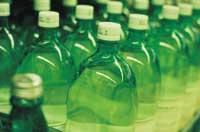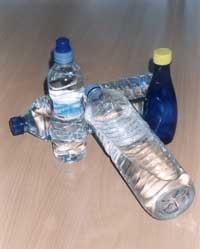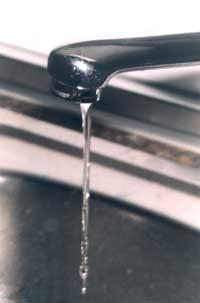Bottled or tap water?
2001/11/11 Mendiburu, Joana - Elhuyar Zientziaren Komunikazioa
It is recommended to drink 1.5 liters of water per day. Water, among other things, optimizes intercellular exchanges, helps regulate body temperature and helps control the amount of uric acid to remove toxins. But, as is often said, is bottled water really more beneficial than tap water? What is the difference, besides the price, between these two waters? By making a classification and adding to the numbers of the water industry, we have found answer to these questions.
Cheap and quality tap water
The bottled water industry has experienced great development in recent decades and its influence is clear. It is estimated that they are healthier than tap water, more and more bottles are consumed. Between the water of the bottle and that of the faucet there are two great differences, the first is the chemical composition and the second the price. Bottled water can be 400 times more expensive than tap water and although in the consumer society it is believed that the expensive price is a guarantee of good quality, before betting on the water of the bottle it is advisable to have things clear.

Without paying attention to advertising, there are some points to mention in favor of tap water. Tap water, as well as bottle water, must meet a number of requirements to be drinkable. In Europe, each country has laws to ensure that tap water is safe and before reaching home sources, this water passes through several controls. Therefore, if a punctual accident does not occur, the faucet is drinking water without fear.
However, unlike most of the water in the bottle, tap water, to meet these conditions, usually passes through various treatments. It first filters to remove the most important impurities. Then, if the water has an excess of ammonia, iron or manganese, it can be precipitated or lowered to a suitable level thanks to some additives.
Finally, to avoid the presence of bacteria, viruses and germs, it is mandatory to disinfect water. For this purpose, ozone, ultraviolet rays or chlorine are used so identifiable to the consumer. The first two methods are not widely used because, in addition to being more expensive, they have no long-lasting effects. Chlorine affects the water until it reaches the tap. It is true that the water of some villages can have an overly chlorine smell and flavor, but it is a product that must be added obligatorily.
The result is to allocate drinking water to homes. But if you are among those who prefer to drink bottled water due to bad taste or for another reason, you have to know what difference there is between the bottles.
Introduction to bottled water

The idea of putting water in the bottles comes from those who came to the spas. These people also wanted to enjoy in their house the benefits of water and began to transport them in bottles. Over time, and especially in the last 50 years, this activity has become an industry. In France, for example, from 1947 to 1998, mineral water production has increased by 20 and has gone from 270 to 5.5 million liters. At present, Europe produces 30 million liters of water per year and its main producers are Germany, Italy and France. In the latter country, the water industry annually moves 13 million pounds (325,000 million pesetas).
Given the development of this industry, it is no surprise that we go to the store and find a dozen water brands. Of different prices, of beautiful design, of mineral waters and of springs, is a great variety and you have to know to classify the waters not to miss in this world.
In general, between the waters of the bottle are distinguished two main types of water. On the one hand, the waters of the spring and, on the other, the mineral waters. Some and others have no microorganism. According to legislation, the water source will be protected against pollution, thus avoiding the presence of nitrates, pesticides and heavy metals. In addition, before entering the bottles, according to European regulations, no additive can be added to the water. The only treatments that can receive water are mechanics, that is, filtration, decantation and ventilation.
The difference between both types of water lies in its chemical composition. The first ones have no peculiarities and mineral waters contain minerals that give them therapeutic properties. Among the mineral waters are also distinguished the quite poor and the very rich. The water is enriched in minerals according to the geological layers that cross to the aquifer.
However, it is known that the price has nothing to do with the quality of water. The price is increased according to the costs of extraction, bottling and transportation of water.
Advice for special cases

The minerals are necessary and when they are eliminated daily by the body, they must be renewed daily thanks to adequate food. The most well-known minerals are calcium, phosphorus, sodium, magnesium, iron, and calcium. As has already been mentioned, balanced food is sufficient to avoid the scarcity of minerals, but in some cases, as in the case of pregnant women, the contribution can be complemented by the intake of mineral water.
On the other hand, some experts recommend the use of water mineral for the preparation of the baby bottle due to the greater guarantee of absence of bacteria and germs and to the greater safety that it contributes despite the good conservation of the dose of chlorine.
Finally, it is worth mentioning the particular case of sodium. And it is that, although sodium is the most important element of the fluids of the human body, excess causes an increase in blood pressure. Consequently, it is recommended to drink sodium free water for people with heart problems.
Published in 7K.

Gai honi buruzko eduki gehiago
Elhuyarrek garatutako teknologia





